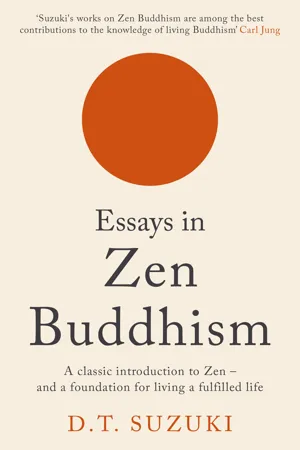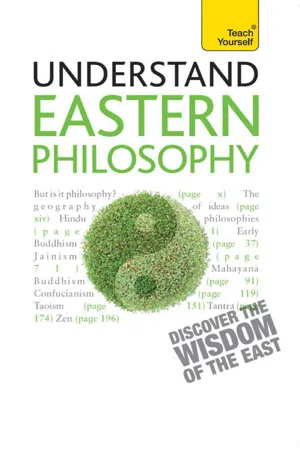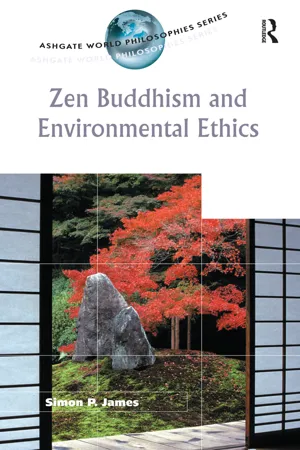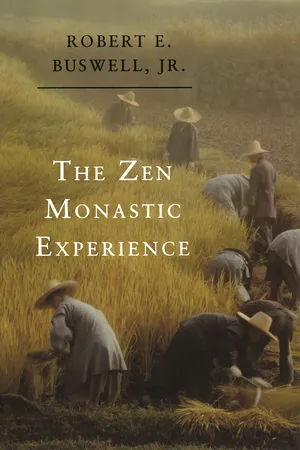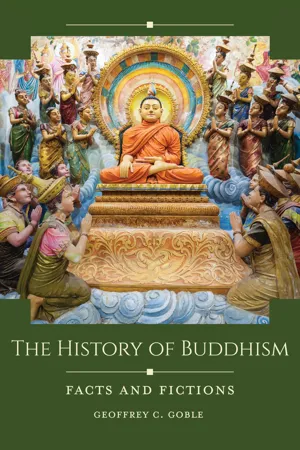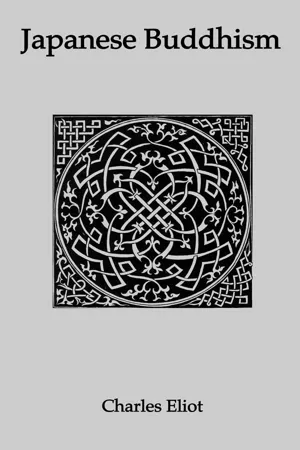History
Zen Buddhism
Zen Buddhism is a school of Mahayana Buddhism that originated in China during the Tang dynasty and later spread to Japan. It emphasizes meditation, mindfulness, and direct experience over theoretical knowledge and ritual. Zen practitioners seek to achieve enlightenment through disciplined meditation and a deep understanding of the nature of reality.
Written by Perlego with AI-assistance
Related key terms
11 Key excerpts on "Zen Buddhism"
- eBook - ePub
- D.T. Suzuki(Author)
- 2011(Publication Date)
- Souvenir Press(Publisher)
HISTORY OF Zen Buddhism FROM BODHIDHARMA TO HUI-NÊNG (YENŌ)(A.D. 520—A.D. 713)M Y INTENTION here is not to make a thoroughly critical and scientific study of the history of Zen Buddhism; for this presupposes some knowledge of the development of Buddhism in China, and there are, as far as my knowledge extends, no text-books on the subject, which are accessible to readers of this book. The main object of the present Essay will therefore be to acquaint them first with the traditional history of Zen as it is told by its followers both in Japan and China. Its critical investigation will follow when readers are in a degree prepared for the task.The traditional origin of Zen in India before its introduction into China, which is recorded in Zen literature, is so mixed with legends that no reliable facts can be gathered from it. In the days when there was yet no critical study of anything and when things, especially relating to religion, were believed in a wholesale manner, we could not expect anything else. It may now be too late to try to unravel the mysteries enveloping the origin of Zen in India except in a general and logical way from the historical facts already known concerning the development of Mahāyāna Buddhism. In fact, Zen Buddhism, as was already discussed, is the product of the Chinese mind, or rather the Chinese elaboration of the Doctrine of Enlightenment. Therefore, when we want to narrate the history of Zen, it may be better in some respects not to go to India but to stay in China and study the psychology and philosophy of her people and the surrounding conditions that made it possible for Zen to achieve a successful growth in the land of the celestials, always remembering that it is a practical interpretation of the Doctrine of Enlightenment. - eBook - ePub
Eastern Philosophy: Teach Yourself
A guide to the wisdom and traditions of thought of India and the Far East
- Mel Thompson(Author)
- 2012(Publication Date)
- Teach Yourself(Publisher)
8 Zen In this chapter you will:• examine the origins and development of Zen• explore key features of Zen Buddhism• consider some 20th-century attempts to relate Zen to Western thought.IntroductionAll Buddhist traditions use meditation as a tool for spiritual development, adopting what had already become a feature of the Hindu religious milieu. The Chinese term for meditation is Ch’an, and the Japanese form of this is Zen. Zen simply means ‘meditation’.As we shall see, however, Zen goes beyond other traditions in that it rejects the possibility of using concepts to describe what is perceived in a moment of insight. Zen is the quest to break down our tendency to conceptualize, encouraging us to deal with reality directly.It might be tempting, therefore, to ask what Zen is doing in a book on Eastern philosophy, since philosophy is primarily about the use of concepts. There are three reasons why it should be included:- It explores the parameters of logical thought. By showing what concepts cannot do, it points to their proper use.
- It is a reminder that ‘wisdom’ – the true object of philosophy – is not simply conceptual, and in doing this it reinforces the breadth of understanding of wisdom in the East, in contrast to the more narrowly defined function of philosophy in a Western academic context.
- It has influenced a number of thinkers who have consciously attempted to develop Eastern philosophy in ways that relate it to Western thought.
KASYAPA’S SMILEAlthough the practice of Zen might be geographically and historically far removed from the teachings of Siddhartha Gautama, it claims to trace its origins to an incident that occurred while the Buddha was teaching. Instead of attempting to explain the Dharma in words, the Buddha was said simply to have held up a flower, turning it in his hand. Kasyapa, one of the disciples present on that occasion, saw the flower and smiled. That smile, devoid of all concepts or explanation, is claimed as the origin of Zen – a direct perception of the nature of reality. - eBook - ePub
- Simon P. James(Author)
- 2017(Publication Date)
- Routledge(Publisher)
Chapter OneA Short History of Zen
The main purpose of this chapter is to explain what Zen is by looking at its historical development.1 Another aim is to introduce the concepts, individuals and historical episodes I will be referring to in subsequent chapters, so that when I refer later in the book to the ‘emptiness teaching’ or to ‘Dōgen Zenji’, for example, readers will know to what or to whom I am referring.The BuddhaIf, as is conventionally held, Bodhidharma is the father of the tradition, then Zen was born in what is now modern day China around the turn of the sixth century CE. We will consider Bodhidharma presently. For the moment, it can be noted that even if this birth certificate is accurate, it is far from illuminating. Zen did not coalesce out of thin air, springing fully-fledged from the furrowed brow of Bodhidharma. To determine the nature of the tradition one must look back to times that even by the sixth century were considered ancient history, and one must look further afield than China. Most obviously, Zen is a form of Buddhism,2 and to understand its nature one must look to the ancient Indian traditions of Buddhism from which it evolved.Buddhism can of course be traced back to the Buddha himself, and so a good place to start in our history of Zen is with an account of the Buddha’s life. (Or rather, an account of how his life has been traditionally understood. I leave the task of sifting the factual elements of it from the legend to historians.) The first thing to note here is that the word ‘Buddha’ means ‘Awakened One’, one who has, as it were, awoken from his spiritual slumber to perceive things as they really are. The title ‘Buddha’ can, moreover, be applied to any beings that have thus awoken, so that one can speak, as many Buddhists do, of a plurality of Buddhas, scattered throughout time and space. However, when people refer to the - eBook - ePub
- Kaiten Nukariya(Author)
- 2014(Publication Date)
- Routledge(Publisher)
The Religion of the SamuraiChapter IHistory of Zen in China
1. Origin of Zen in India .—To-day Zen as a living faith can be found in its pure form only among the Japanese Buddhists. You cannot find it in the so-called Gospel of Buddha any more than you can find Unitarianism in the Pentateuch, nor can you find it in China and India any more than you can find life in fossils of bygone ages. It is beyond all doubt that it can be traced back to Shakya Muni himself, nay, even to pre-Buddhistic times, because Brahmanic teachers practised Dhyana, or Meditation,1 from earliest times. But Brahmanic Zen was carefully distinguished even by early Buddhists1 as the heterodox Zen from that taught by the Buddha. Our Zen originated in the Enlightenment of Shakya Muni, which took place in his thirtieth year, when he was sitting absorbed in profound meditation under the Bodhi Tree. It is said that then he awoke to the perfect truth and declared: “All animated and inanimate beings are Enlightened at the same time.” According to the tradition1 of this sect Shakya Muni transmitted his mysterious doctrine from mind to mind to his eldest disciple Mahākāçyapa at the assembly held on the Mount of Holy Vulture, and the latter was acknowledged as the first patriarch, who, in turn, transmitted the doctrine to Ānanda, the second patriarch, and so till Bodhidharma, the twenty-eighth1 patriarch. We have little to say about the historical value of this tradition, but it is worth while to note that the list of the names of these twenty-eight patriarchs contains many eminent scholars of Mahāyānism, or the later developed school of Buddhism, such as Açvaghoṣa,2 Nārgārjuna,3 Kāṇadeva,4 and Vasubhandhu.52. Introduction of Zen into China by Bodhidharma .—An epoch-making event took place in the Buddhist history of China by Bodhidharma’s coming over from Southern India to that country in about A.D . 520.1 - eBook - ePub
The Zen Monastic Experience
Buddhist Practice in Contemporary Korea
- Robert E. Buswell Jr., Robert E. Buswell, Jr.(Authors)
- 2020(Publication Date)
- Princeton University Press(Publisher)
Part of the problem, I presumed, was that Zen seemed so different from Buddhism as I had experienced it earlier as a monk in Southeast Asia. My own monastic study of Zen thought started as a result of trying to understand how Zen—which claimed to be Buddhist, but which seemed in so many ways to be almost diametrically opposed to the tenets and practices of much of the rest of the Buddhist religion—could be reconciled with the mainstream of the Sino-Indian tradition. Could “Zen,” in other words, still be “Buddhism”?When I broached this question with Korean monks, they found it ludicrous.12 Of course we are Buddhists, they would reply, and could readily point to the Buddha images in their shrine halls to verify this fact, if not the protracted succession of Zen masters they recognized, going back to Śākyamuni Buddha himself. But the monks’ attempts to assuage my concerns were never completely satisfying. Since leaving the monastery in 1979 to return to the academy, I have built my scholarly career upon the problem of placing Zen within the wider context of pan-Asiatic Buddhist thought. This has led to two books that explore the development of Zen thought and meditative techniques and their affinities with other strands of Buddhist doctrine and practice.13 As I look back on my career now, however, this quandary I faced in understanding Zen’s connections with the rest of Buddhism might not have occurred had I been content to let monastic practice itself represent the experience of Zen Buddhism and not attempt to unravel its theory, as Renato Rosaldo encourages in the epigraph that opens this introduction.14MONASTICISM AND THE CONTEXT OF ENLIGHTENMENT
I expect some readers will presume that, in my concern with what might be considered the “external trappings” of the Zen tradition, I am neglecting the internal religious training that is thought to be the lifeblood of the religion. Who really cares, some might ask, about the minutiae of monastic training, about what time the monks get up in the morning, or what duties they perform in the monastery? All that really matters in Buddhism—and especially in Zen—is enlightenment; and that enlightenment has little to do with monastic organization, daily routines, and other cultural artifacts of the religion. I have often heard such arguments, especially it seems from Western Zen practitioners, but I reject them out of hand. I have come to believe that Buddhism weaves doctrine, praxis, and lifeway together into an intricate tapestry. In this tapestry, the daily rituals of Buddhism reticulate with its teachings and its practices, each aspect intimately interconnected with the other. The regimens of monastic life— indeed, the entire cultural context of Buddhist training—therefore interface directly with doctrine and practice.15 - eBook - ePub
The History of Buddhism
Facts and Fictions
- Geoffrey C. Goble(Author)
- 2019(Publication Date)
- ABC-CLIO(Publisher)
For Orientals these mysterious formulae are clear and familiar truths, but for us they are completely bewildering. We have therefore to go into this question more deeply. For some considerable time it has been no secret, even to us Europeans, that the Japanese arts go back for their inner form to a common root, namely Buddhism. This is true of the art of archery as of ink painting, of the art of the theater no less than the tea ceremony, the art of flower arrangement, and swordsmanship. All of them presuppose a spiritual attitude that cultivates in its own way—an attitude which, in its most exalted form, is characteristic of Buddhism and determines the nature of the priestly type of man. I do not mean Buddhism in the ordinary sense, nor am I concerned here with the decidedly speculative form of Buddhism, which, because of its allegedly accessible literature, is the only one we know in Europe and even claim to understand. I mean Dhyana Buddhism, which is known in Japan as “Zen” and is not speculative at all but immediate experience of what, as the bottomless ground of Being, can not be apprehended by intellectual means, and cannot be conceived or interpreted even after the most unequivocal and incontestable experiences: one knows it by not knowing it. For the sake of those crucial experiences Zen Buddhism has struck out on paths which, through methodical immersion in oneself, lead to one becoming aware, in the deepest ground of the soul, of the unnamable Groundlessness and Qualitylessness—nay, more, to one’s becoming one with it. And this, with respect to archery and expressed in very tentative and on that account possibly misleading language, means that the spiritual exercises, thanks to which alone the technique of archery becomes an art and, if all goes well, perfects itself as the “artless art,” are mystical exercises, and accordingly archery can in no circumstances mean accomplishing anything outwardly with bow and arrow, but only inwardly, in oneself. Bow and arrow are only a pretext for something that could just as well happen without them, only the way to a goal, not the goal itself, only helps for the last decisive leap.In view of all this, nothing would be more desirable that that one should be able to lay hands on expositions by Zen Buddhists as an aid to understanding. These are in fact not lacking. In his Essays in Zen Buddhism, D. T. Suzuki has succeeded in showing that Japanese culture and Zen are intimately connected and that Japanese art, the spiritual attitude of the Samurai, the Japanese way of life, the moral, aesthetic and to a certain extent even the intellectual life of the Japanese owe their peculiarities to this background of Zen and cannot be properly understood by anybody not acquainted with it.Source: Eugen Herrigel, Zen in the Art of Archery, trans. R. F. C. Hull (New York: Pantheon Books), 5–7. Copyright © 1953, copyright renewed 1981 by Penguin Random House LLC. Used by permission of Pantheon Books, an imprint of the Knopf Doubleday Publishing Group, a division of Penguin Random House LLC. All rights reserved.What Really HappenedZen refers to the Japanese form of a school of East Asian Buddhism that originated in China. In China, this school is referred to as Chan (also written as Ch’an). Chan Buddhism first emerged as a particular variety of Buddhism in China during the eighth century, though the Chan School traces its own history in China to the figure of Bodhidharma, who is believed to have lived in the fifth and sixth centuries. But, like other schools of Buddhism, Chan ultimately traces its origins to the person of the Buddha Śākyamuni. The Chan School represents itself as an unbroken lineage of enlightened masters who transmitted the “mind of enlightenment,” or the experience of full, salvific realization. According to Chan orthodoxy, this lineage of enlightened masters was initiated by Śākyamuni Buddha and was passed down to a series of twenty-eight “patriarchs” in India. The last in this series of patriarchs is Bodhidharma, who is said to have travelled from India to China and to have transmitted the mind of enlightenment to his disciple Huike 慧可 (487–593). The enlightened mind was transmitted from Huike to a series of four other patriarchs—each of whom is believed to have attained the same enlightened realization as Śākyamuni Buddha. The sixth figure in the Chinese Chan lineage is Huineng 惠能 (638–713). Following Huineng, the Chan Buddhist lineage is understood to have split, producing multiple subschools, typically referred to as “houses” or “families” ( jia 家 - eBook - ePub
Awakening
An Introduction to the History of Eastern Thought
- Patrick S. Bresnan(Author)
- 2016(Publication Date)
- Routledge(Publisher)
Various Buddhist disciplines, including meditation, might have a role to play, but no practice can achieve awakening. Through the guidance of an already awakened teacher, an individual can be urged to the state wherein he or she may be willing to let go of attachment-to-self and suddenly and spontaneously see the real truth of one’s nature. The real truth is, of course, the Buddha-nature, which is the common essence of all beings, hidden from us only by our ignorance and the fear born of that ignorance. The time following the death of Huineng was a time of consolidation and enrichment for Zen Buddhism. Daoist influences, always strong within the culture of China, were richly woven into the fabric of Zen during that time. Zen experienced near-explosive growth during the late Tang and Song periods. Zen was far from being the only Buddhist sect in China, though. Early Zen itself had been richly influenced by Tiantai Buddhism, the most prominent school of Buddhism in China at that time. In fact, Buddhist groups were so numerous and diverse as to be likened to the trees of a forest. Zen was only one part of the forest—an important part to be sure—but just one part nonetheless. Not all Buddhists were (or are) monks. One of the great attractions of Mahayana Buddhism is that it offers something for everyone. Laymen and women could also enjoy a rich Buddhist way of life. But those few who were willing to give up everything and dedicate their lives one hundred percent to practicing the Buddhist disciplines—in other words, the monks—would remain at the core of the movement. From the very beginning of Buddhism in China, dedicated men and women formed themselves into monastic communities. * We have encountered references to monasteries often in the story of Buddhism’s evolution in China. Bodhidharma, for example, stayed for nine years at the “monastery” of Shaolinsi - eBook - ePub
The Religion of the Samurai
A Study of Zen Philosophy and Discipline in China and Japan
- Kaiten Nukariya(Author)
- 2004(Publication Date)
- Perlego(Publisher)
The historical importance of Zen can hardly be exaggerated. After its introduction into China in the sixth century, A.D., it grew ascendant through the Sui (598-617) and the Tang dynasty (618-906), and enjoyed greater popularity than any other sect of Buddhism during the whole period of the Sung (976-1126) and the Southern Sung dynasty (1127-1367). In these times its commanding influence became so irresistible that Confucianism, assimilating the Buddhist teachings, especially those of Zen, into itself and changing its entire aspect, brought forth the so-called Speculative philosophy.[FN#13] And in the Ming dynasty (1368-1659) the principal doctrines of Zen were adopted by a celebrated Confucian scholar, Wang Yang Ming,[FN#14] who thereby founded a school, through which Zen exercised profound influence on Chinese and Japanese men of letters, statesmen, and soldiers.As regards Japan, it was first introduced into the island as the faith first for the Samurai or the military class, and moulded the characters of many distinguished soldiers whose lives adorn the pages of her history. Afterwards it gradually found its way to palaces as well as to cottages through literature and art, and at last permeated through every fibre of the national life. It is Zen that modern Japan, especially after the Russo-Japanese War, has acknowledged as an ideal doctrine for her rising generation.[FN#13] See 'A History of Chinese Philosophy,' by Ryukichi Endo, and A History of Chinese Philosophy,' by Giichi Nakauchi. [FN#14] For the life of this distinguished scholar and soldier (1472-1529), see 'A Detailed Life of O Yo Mei’ by Takejiro Takase, and also 'O-yo-mei-shutsu-shin-sei-ran-roku.'CHAPTER I
HISTORY OF ZEN IN CHINA
1. Origin of Zen in India.To-day Zen as a living faith can be found in its pure form only among the Japanese Buddhists. You cannot find it in the so-called Gospel of Buddha anymore than you can find Unitarianism in the Pentateuch, nor can you find it in China and India any more than you can find life in fossils of bygone ages. It is beyond all doubt that it can be traced back to Shakya Muni himself, nay, even to pre-Buddhistic times, because Brahmanic teachers practised Dhyana, or Meditation,[FN#15] from earliest times. - eBook - ePub
Developments in Australian Buddhism
Facets of the Diamond
- Michelle Spuler(Author)
- 2014(Publication Date)
- Routledge(Publisher)
The first to emerge was the Theravada tradition, also known as the School of the Elders, or Hinayana (Lesser Vehicle). Theravada Buddhism is now the main Buddhist tradition in Sri Lanka, Myanmar, Cambodia, Laos and Thailand. In the first century BCE the Mahayana (or Great Vehicle) tradition emerged, and gradually spread into China, Japan, Korea and Vietnam. The third major tradition, Vajrayana (the Diamond Vehicle) developed later and in the seventh century its spread to Tibet, Nepal and Mongolia. These three major traditions developed differently in different countries, diversifying even further through the development of different groups within and across geographical regions. It is generally accepted that all Buddhists affirm a few core tenets (although they may express or emphasise these differently): the Four Noble Truths, the Noble Eight-Fold Path, the Three Universal Characteristics and the Three Jewels. 1 Japanese Zen Buddhism Zen Buddhism is a branch of Mahayana Buddhism that originated in India. According to myth, the Buddha established the foundations of Zen Buddhism during a discourse on Vulture Peak in which he did not speak, but simply held up a flower. Only one of the Buddha’s students, Kashyapa, understood this message, and had an experience of enlightenment. Taking the honorific, ‘Maha’, Mahakashyapa thus became the first Indian patriarch in the Zen Buddhist lineage. Legend continues that an Indian monk, Bodhidharma, transmitted these teachings to China around 500 CE. Bodhidharma’s teachings mixed with Taoism in China to form a new school of Mahayana Buddhism, called Ch’an. Ch’an is the Chinese pronunciation of the Sanskrit word, dhyana, which means meditation. Bodhidharma is considered the first patriarch of Ch’an, and the twenty-eighth patriarch in the Indian lineage. The two schools of Ch’an that became prominent in Japan, Rinzai and Soto, were introduced into Japan in the twelfth and thirteenth centuries, respectively - eBook - ePub
- John M. Koller(Author)
- 2018(Publication Date)
- Routledge(Publisher)
The Zen emphasis on the immediacy and completeness of present experience shows up in the underlying principles of Zen practice, in the quality of enlightened life, and in the teachings underlying Zen. Of these three basic features of Zen—practice, enlightenment, and teachings—it is practice that comes first. Enlightenment cannot be separated from practice, and teachings support and are determined by practice and enlightenment. It is fitting, therefore, that we should turn now to a description of the practice of Zen.ZazenZazen, the chief discipline of Zen, is practiced in order to see directly into reality. In the direct insight of mindfulness practice one discovers in the purity of one’s own mind the true nature of all existence. This discipline requires assuming complete control and regulation of the hands, feet, legs, arms, trunk, and head. Next, breathing must be regulated and the activities of the mind calmed. Through a series of special forms of concentration the activities of the mind are brought together, unified, and stilled. The emotions and volitions are also brought under control and harmonized with the mind. Having attained the foregoing, it remains to cultivate what is sometimes called a profound silence in the deepest recesses of one’s being, letting go of all dualistic thought and all graspings.Why engage in the discipline of zazen? There are many good reasons to practice zazen. Centuries ago, Japanese warriors practiced zazen to improve their fighting skills. Today, athletes around the world practice zazen to improve their performance. Many people practice zazen as a kind of therapy to relieve personal stress. Some Japanese companies send their managers for a week of zazen practice to learn self-discipline. But the traditional reason for practice is that zazen is the practice of mindfulness that the Buddha taught as the way out of suffering. It is the practice of zazen that brings peace through the deep insight into reality that Buddhists recognize as enlightenment.Zen presupposes that ordinarily a person is caught up in a confusion of ideas, theories, reflections, prejudices, feelings, and emotions that prevent one from experiencing things in their wholeness, as they really are. The discursive mind divides reality into segments, which it then arranges into objects, connected to each other and to the subject through a series of relationships created by the mind. Thus, ordinarily a person does not really experience reality, but only the mind’s network of ideas and feelings about reality. These ideas and feelings always stand between the individual and reality, mediating the experience. The aim of zazen - eBook - ePub
- Charles Eliot(Author)
- 2014(Publication Date)
- Routledge(Publisher)
It was not a suitable religion for Japan in the seventh or eighth centuries because what was needed then was a clear and decided creed which could school and civilize a people among whom the masses were in a rudimentary stage of culture. But things were very different about 1200, when men's minds were weary of the old religious forms, and new sects, national and Japanese, were coming into being. Zen did not spring up like the systems of Shinran and Nichiren: it was introduced by the time-honoured process of Japanese going to China and bringing back the instruction which they had received there. Still, the instruction was so flexible and contained so little that was in any way suggestive of Chinese nationality and usages that Zen has become as decidedly Japanese as tea ceremonies or Nō plays.The future which awaited it was not what might have been expected. It might have been supposed that in a troubled period this contemplative and mystic doctrine, which finds truth not in scripture but in the immediate experience of the human mind, would have flourished in monastic harbours of refuge among those who had left the storms of the world, but not that it would have been accepted as the favourite rule of life for the military class. Yet such it became and the cause of the transformation is clear. Soldiers were not repelled by a doctrine which held that book learning is useless, and Zen is essentially discipline. The mind in which it trusts is not the wayward impulsive mind but the mind which is in training to win the race for truth, the mind which is receptive but under control, which remains calm and collected though threatened by physical danger from without or assailed by passion from within. Such a mind makes a soldier as well as an abbot. A well-known story relates that when Nobunaga was fighting against Takeda in the province of Kai his troops surrounded and set fire to a temple. The priest Kwaisen Shōki with his companions perished in the flames as he recited an impromptu poem which he had composed saying that even fire is cold to the mind that thinks it is. This shows how the military, priestly, and poetic ideals can sometimes unite.
Index pages curate the most relevant extracts from our library of academic textbooks. They’ve been created using an in-house natural language model (NLM), each adding context and meaning to key research topics.
